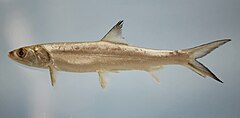Elopsowate
Wygląd
| Elopidae | |||
| Valenciennes, 1847[1] | |||
 Przedstawiciel rodziny – elops złotawy (Elops saurus) | |||
| Systematyka | |||
| Domena | |||
|---|---|---|---|
| Królestwo | |||
| Typ | |||
| Podtyp | |||
| Gromada | |||
| Podgromada | |||
| Infragromada | |||
| Nadrząd | |||
| Rząd | |||
| Rodzina |
elopsowate | ||
| Typ nomenklatoryczny | |||
|
Elops Linnaeus, 1766 | |||
| Synonimy | |||
|
| |||
| Rodzaje | |||
| |||
Elopsowate[5], oszczerowate[6] (Elopidae) – rodzina ławicowych ryb promieniopłetwych z rzędu elopsokształtnych (Elopiformes).
Występowanie
[edytuj | edytuj kod]Ciepłe i tropikalne wody morskie, rzadko wpływają do estuariów i rzek[7].
Cechy charakterystyczne
[edytuj | edytuj kod]Ciało silnie wydłużone, o długości do 100 cm (u Elops machnata), zakończone głęboko wciętą płetwą ogonową. Nasada płetwy grzbietowej rozpoczyna się tuż za nasadą płetw brzusznych. W płetwach występują tylko promienie miękkie. Ostatni promień płetwy grzbietowej jest najkrótszy[5]. Duży otwór gębowy w położeniu końcowym, wyposażony w drobne zęby. Łuski drobne, w liczbie 95–120 w linii bocznej. Liczba kręgów od 63 do 79[7].
Klasyfikacja
[edytuj | edytuj kod]Rodzaje zaliczane do tej rodziny:
- współcześnie żyjące[8]
- wymarłe[9]
- Anaethalion White, 1938
- Davichthys Forey, 1973
Zobacz też
[edytuj | edytuj kod]Przypisy
[edytuj | edytuj kod]- ↑ a b A. Valenciennes: Suite du livre dix-neuvième. Brochets ou Lucioïdes. Livre vingtième. De quelques familles de Malacoptérygiens, intermédiaires entre les Brochets et les Clupes. W: G. Cuvier & A. Valenciennes: Histoire naturelle des poissons. T. 19: Suite du livre neuvième. Des Scombéroïdes. Paris: Chez F. G. Levrault, 1847, s. 358. (fr.).
- ↑ J. Richardson: Ichthyology of the voyage of H. M. S. Erebus & Terror, under the command of Captain Sir James Clark Ross, R. N., F. R. S.. W: J. Richardson & J.E. Gray: The zoology of the voyage of the H.M.S. Erebus & Terror, under the command of Captain Sir James Clark Ross, during the years 1839 to 1843. By authority of the Lords Commissioners of the Admiralty. Cz. 2: Reptiles, Fishes, Crustacea, Insects, Mollusca. London: E. W. Janson, 1844–1848, s. v. (ang.).
- ↑ A.C.L.G. Günther: Catalogue of the Physostomi, containing the families Heteropygii, Cyprinidæ, Gonorhynchidæ, Hyodontidæ, Osteoglossidæ, Clupeidæ, Chirocentridæ, Alepocephalidæ, Notopteridæ, Halosauridæ, in the British Museum. Cz. 7. London: British Museum (Natural History), Department of Zoology, 1868, s. 382, 469, seria: Catalogue of the fishes in the British Museum. (ang.).
- ↑ G.P. Whitley. Illustrations of some Australian fishes. „Australian zoologist”. 9 (4), s. 397, 1940. (ang.).
- ↑ a b S. Rutkowicz: Encyklopedia ryb morskich. Gdańsk: Wydawnictwo morskie, 1982, s. 50. ISBN 83-215-2103-7.
- ↑ E. Grabda & T. Heese: Polskie nazewnictwo popularne: krągłouste i ryby. Cyclostomata et Pisces. Koszalin: Wyższa Szkoła Inżynierska w Koszalinie, 1971, s. 32. ISSN 0239-7129.
- ↑ a b Joseph S. Nelson: Fishes of the World. John Wiley & Sons, 2006. ISBN 0-471-25031-7.
- ↑ Ron Fricke, William Neil Eschmeyer, Richard van der Laan (red.), SEARCH, [w:] Eschmeyer’s Catalog of Fishes, California Academy of Sciences, 2 kwietnia 2024 [dostęp 2024-04-26] (ang.).
- ↑ The Taxonomicon & Systema Naturae 2000 (dostęp 4 sierpnia 2012)
Bibliografia
[edytuj | edytuj kod]- Froese, R. & D. Pauly: Family Elopidae - Tenpounders. FishBase. World Wide Web electronic publication. www.fishbase.org, 2008. [dostęp 2009-03-02]. (ang.).
- Kent E. Carpenter: The Living Marine Resources of the Western Central Atlantic, Vol. 3. Food and Agriculture Organization of the United Nations. ISBN 92-5-104827-4.